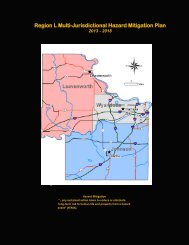Wireless Emergency Alerts - Prepare Metro KC
Wireless Emergency Alerts - Prepare Metro KC
Wireless Emergency Alerts - Prepare Metro KC
You also want an ePaper? Increase the reach of your titles
YUMPU automatically turns print PDFs into web optimized ePapers that Google loves.
Integrated Public Alert and Warning System<strong>Wireless</strong> <strong>Emergency</strong> <strong>Alerts</strong>In weather emergencies, warnings can save lives.But traditional warning methods such as television,radio and outdoor sirens don’t always reacheveryone.By July 2012, emergency officials will havea new way to send warnings directly to cellphones in affected areas — <strong>Wireless</strong> <strong>Emergency</strong><strong>Alerts</strong> (WEAs).These short messages may look like a textmessage, but unlike texts, which are sent directlyto your phone number, these warnings will bebroadcast to all phones within range of designatedcell towers through the Commercial Mobile AlertSystem (CMAS).The alerts will tell you the type of warning, theaffected area, and the duration. You’ll need to turnto other sources, such as television or your NOAAAll-Hazards radio, to get more detailed informationabout what is happening and what actions youshould take.Key Things to Know:OOWEA messages may look like a text, or appearover your home screen.OOThe alert message will include a uniqueringtone and vibration.OOYou will never be charged for WEA messages.OO<strong>Emergency</strong> alerts will not interrupt any calls ordownloads in progress. If you’re on the phonewhen the alert goes out, you’ll get the messagewhen you end your call.OOYou need not have GPS or any other specialfeatures turned on to receive the alerts.OOThe system does not identify your location orphone number — it simply sends the messageto all devices in a given area.OOIf you’re on the road and enter an area with anactive warning, you’ll receive a WEA messageas soon as you come within range of one of theaffected cell towers.For illustration only. Actual message appearance will vary.Is your phone ready for WEA?If you have an older model phone, you maynot receive the <strong>Wireless</strong> <strong>Emergency</strong> <strong>Alerts</strong>.Some, such as newer-model iPhone andAndroid phones, will soon receive softwareupdates that add this feature.Check with your service provider to findout if your phone is WEA-capable. AT&T,Cricket, Sprint, T-Mobile and Verizon allhave information about the new alert systemon their websites. Search for WEA (<strong>Wireless</strong><strong>Emergency</strong> <strong>Alerts</strong>) or CMAS (CommercialMobile Alert System) to find your provider’slist of WEA-capable phones.
Cell tower geography may lead to temporary overwarningBecause cell towers broadcast in aradius, or circle, their coverage areasdon’t line up neatly with countyboundaries. This means you may receivewarnings for an adjacent county if you’rewithin a few miles of the border.The alerts are delivered directly fromcell tower to cell phone through a onewaybroadcast. The Commercial MobileAlert System does not track or locateindividual cell phones or phone numbers— it simply broadcasts to all phoneswithin range. Unfortunately, in somecases, this may result in overwarning.For example, if a tornado warningis issued for a particular county,it will go to all towers that servethat county. Towers in urban areasgenerally serve a radius of two to fivemiles, and in rural areas up to 10 miles,so the warning message may reach alittle beyond the warning boundaries.Technicians will work to solveoverwarning problems, and residents areasked to be patient as adjustments aremade to the new system.As this simplified illustration shows, whena warning is issued for County 1, peoplein County 2 and County 3 who are withinrange of a tower that servesthe warned county willCOUNTY 2also get the message.COUNTY 1In reality, there are hundredsof towers with overlappingservice areas throughout theKansas City area.COUNTY 3<strong>Wireless</strong> <strong>Emergency</strong> <strong>Alerts</strong>: Three Types of WarningsThe Commercial Mobile Alert System (CMAS)can be used to broadcast three types ofemergency alerts:OOPRESIDENTIAL ALERTS — Issued by theU.S. President in the event of a nationwideemergency.OOIMMINENT THREAT ALERTS — Typicallyissued by the National Weather Service; inthe Kansas City metropolitan area, thesewould include tornado, flash flooding, icestorm and blizzard warnings.OOAMBER ALERTS — Issued by lawenforcement to share information about achild abduction.No president has ever yet had to issue apresidential alert, but should one becomenecessary, cell phone providers are required tobroadcast it to all WEA-capable phones.Cell phone users may choose to opt out ofimminent threat and/or AMBER alerts, but theprocedures vary by carrier. Some providerswill allow customers to opt out of one or theother, while others only allow you to opt out ofboth. Contact your wireless provider for moreinformation.The <strong>Metro</strong>politan <strong>Emergency</strong> Managers Committeestrongly encourages all residents not to opt out ofthese potentially life-saving messages.To learn more, contact your local emergency management office or wireless service provider.Visit www.preparemetrokc.org for more information on emergency preparedness.









